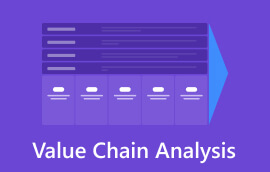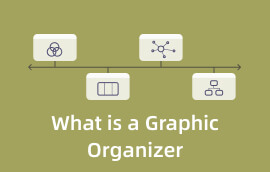What is Supply Chain Analysis & Its Uses? How to Create Its Diagram
Supply chain analysis is a vital part of the business industry. It gives organizations a comprehensive view of the journey of the products or services. It will start from the creation to reaching the hands of the customers. Hence, it is also vital to have a diagram of this analysis. In that way, everything will be easier to understand. Here, we’ll show you how to do a diagram using one of the best supply chain analysis tools. We have also discussed what this analysis is all about, including its uses.

- Part 1. What is Supply Chain Analysis
- Part 2. Uses of Supply Chain Analysis
- Part 3. How to Make a Supply Chain Diagram
- Part 4. FAQs About Supply Chain Analysis
Part 1. What is Supply Chain Analysis
A supply chain analysis is the whole process of producing and delivering a product or a service. It includes the beginning and the end of the production. It will start from getting raw materials to creating the product and delivering it to the customers. It is a detailed analysis that lets businesses understand their supply chain operations. Also, it identifies inefficiencies and areas for improvement to make informed decisions. Supply chain managers take care of supply chains. They track lead time and ensure each step works together. Lead time refers to the time it takes for a process from start to finish. Now, here are the fundamental steps of a supply chain.
◆ Sourcing raw materials.
◆ Making basic parts from the materials.
◆ Putting the parts together to create a product.
◆ Selling and filling orders.
◆ Delivering the product.
◆ Customer support and return services.
Take a look at an example of a supply chain diagram template below that you can use as a reference.

Get a detailed supply chain diagram template.
Example: Generic Supply Chain
Here’s a generic example of how a company's operations and logistics move around. First, the company gets the raw materials from suppliers. Then, they make the final product. After that, they send it to stores and shops. Finally, people like you and me can buy the product from those stores.

Get a detailed Generic supply chain.
Part 2. Uses of Supply Chain Analysis
Supply chain analysis is important to almost all types of businesses. Its purpose is to understand the operations around producing a product or service. In this part, we’ll explore the uses of supply chain analysis.
1. Understand Product Quality
Customers usually talk about products on the internet, call for help, or share thoughts on social media. Thus, they provide useful information for businesses. Companies can gather these details and look at them together to find common feedback. Feedback from customers helps you figure out if a product has any issues with its quality. Also, if there should be an improvement to satisfy them.
2. Improve Efficiency
Supply chain analysis helps businesses analyze data connected to their supply chains. Thus allowing them to do things better and faster. For example, it might show that it takes too long for a product to get from the factory to the store. By making this process efficient, they can save time and get products to customers sooner.
3. Risk Management
Think of supply chain analysis like a crystal ball that helps businesses see into the future. It can predict issues like delays in shipping or shortages of materials. Through these, companies can make plans to deal with them so they don't harm the business.
4. Cost Reduction
It's like looking at all the money a business spends on getting products to customers. Supply chain analysis helps find areas of inefficiency and waste in the supply chain. In that way, they will get things where they need to be. So it also means more profit for the company.
Part 3. How to Make a Supply Chain Diagram
Do you plan to create supply chain example diagrams but do not have an idea what tool to use? Fret not, as MindOnMap can assist you in making an analysis diagram. Plus, it is a reliable chart maker.
MindOnMap is a free online tool that you can access on popular web browsers. It includes Safari, Google Chrome, Edge, Firefox, and so on. It is also rich with features and functions, letting you create your desired diagram. The tool provides several layout templates that you can choose and use. Not only that, it offers various icons and themes. It lets you add shapes, lines, text boxes, color fills, and more. You can also insert links and pictures to make your chart intuitive. What’s more, it has a collaboration feature. It’s a feature that lets you collaborate with your colleagues and peers in real-time. Apart from that, it also has an auto-saving function. It means the platform saves all the changes you made on your diagram. Now, to know how it works, here’s a simple guide for you.
To start with, head to the official website of MindOnMap. Afterward, choose from the Free Download and Create Online options to access its main page. Then, create an account.
Secure Download
Secure Download
After signing up, you’ll be able to see the main interface of the tool. Next, choose the layout that you wish to use. In this guide, we used the Flowchart layout.

Now, begin personalizing your supply chain diagram. Add the shapes, lines, texts, etc., you need for your chart. You can also choose a theme you want.

If you wish to collaborate with your teammates or organization, do it by sharing your diagram. Click the Share button at the upper-right part of your current interface. Then, set the Valid Period and Password for it. Finally, click the Copy Link button and share it.

When you’re done and satisfied, hit the Export button to save your work on your computer. Next, choose your desired output format. And wait until the exporting process is done.

Further Reading
Part 4. FAQs About Supply Chain Analysis
What are the 7 parts of the supply chain?
There are 7 parts of the supply chain. It includes purchasing, manufacturing, inventory management, demand planning, warehousing, transportation, and customer service.
What is a supply chain in simple terms?
The supply chain is the whole process of sourcing the product or services to the end-user.
What is the best way to explain the supply chain?
The best way to explain the supply chain is that it's like a journey. It is where a product or service takes, from where it's made to where it's needed. While also involving various steps like making, moving, and delivering.
Conclusion
To conclude, the supply chain diagram and its analysis itself have proven to be helpful to various businesses. It lets you see the essential steps in the process and understand how these interact with each other. If you also wish to create your diagram, use MindOnMap as your assistance. It is a dependable and resourceful tool to make any type of diagram. Also, with its straightforward functionalities, it is suitable for both professionals and beginners.










